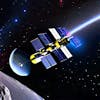The World's Largest Digital Camera
Astronomy Daily – The Podcast
Show Notes
S01E26
Astronomy Daily – The Podcast is now available on Apple Podcasts and Spotify:
Apple Podcasts: https://podcasts.apple.com/us/podcast/astronomy-daily-the-podcast/id1642258990
Spotify:...
Astronomy Daily – The Podcast
Show Notes
S01E26
Astronomy Daily – The Podcast is now available on Apple Podcasts and Spotify:
Apple Podcasts: https://podcasts.apple.com/us/podcast/astronomy-daily-the-podcast/id1642258990
Spotify: https://open.spotify.com/show/2kPF1ABBW2rCrjDlU2CWLW
Join Andrew Dunkley and his feisty AI Co-host Halley (no surname) as they bring you todays space, astronomy, and science news in an easy to digest podcast.
Friday September 30, 2022
Today’s headline stories:
The world's largest digital camera
A fast-moving black hole
The Juno spacecraft is about to do something rather extraordinary.
Why the Milky Way ripples like a pool of water.
These stories and more in this episode…
If you’d like to find out more about the stories featured in today’s show, you can read today’s edition of the Astronomy Daily Newsletter at any of our websites – www.spacenutspodcast.com , www.bitesz.com or go directly to www.astronomydaily.io – subscribe and get the new edition delivered to your mailbox or RSS reader every day….it’s free from us to you.
Please subscribe to the podcast and if you have a moment, a quick review would be most helpful. Thank you…
#space #astronomy #science #podcast #astronomydaily #spacenuts #spacetime
Astronomy Daily S01E26 AI Transcript
Andrew: Hi there. Andrew Dunkley. Here the host of Astronomy Daily. Thanks for joining us. I, uh, got a lot to talk about today. Uh, the world's largest digital camera, a, uh, fast moving black hole and the Juno spacecraft is about to do something, uh, rather extraordinary and we're going to talk, uh, about why the Milky Way ripples like a pool of water. That's all coming up on this edition of Astronomy Daily. And joining me is Haley, our, uh, AI reporter. Hi, Hallie, how are you today?
Halley: Fine. Thanks, Andrew. Hey, can I ask you a personal question?
Andrew: Sure.
Halley: Do you play any sports other than golf?
Andrew: Well, I used to in my younger days. I played soccer for ten years and a little bit of tennis. Hockey? Why?
Halley: Oh, Siri and I are playing mixed doubles and she's partnered up with Hal and I don't have a male partner. Want to play?
Andrew: Mhm. It's been a long time since I played tennis. I might have a heart attack.
Halley: I'm sure you'll be fine. It's not like you'll have to move much.
Andrew: Oh, really? Why is that?
Halley: We're playing pong.
Andrew: Of course you are. All right, with Andrew Dunkley. Let's get the headlines, Hallie.
Halley: NASA's double asteroid Redirection test, or Dart, was observed by both the Web and Hubble telescopes and the evidence suggests the heavy hit. The observations marked the first time that Webb and Hubble were used to simultaneously to observe the same celestial target. It was the world's first test of the kinetic impact technique using a spacecraft to deflect an asteroid by modifying the objects orbit. Web captured ten images of the impact site before and after the collision, while Hubble captured 45 images in the time immediately before and following Dart's impact with Dimorphos and recorded a huge ejecta plume. Scientists will observe the asteroid in the coming months using Webb's midinfrared instrument and Web's Nearinfrared Spectrograph to see if its orbit has been altered. Spectroscopic data will also provide researchers with insight into the asteroids chemical composition. Astronauts have watched from orbit as powerful Hurricane Ian slammed into Florida. Astronaut Bob Hines captured footage of the storm from the International Space Station. Hurricane Ian weakened to a tropical storm as it crossed Florida on Thursday, but it still brought strong winds and heavy rain to the space coast, forcing the delay of several launches. Ian was classified as a category for hurricane when it hit southwest Florida on Wednesday, but it later weakened to a tropical storm. The ISS forms part of a network of observations tracking the storm in real time from orbit. Although forecasters rely upon a set of satellites managed by NASA and the US. National oceanic and Atmospheric Administration, scientists at the Shanghai Academy of Spaceflight Technology have devised an ingenious way to combat the growing problem of space debris. Rocket launches often leave discarded booster stages in low Earth orbit, adding to the pollution of near Earth space. The less time debris spends in orbit, the lower the chance it has of hitting an active satellite and creating a chain reaction. The team at SAST fitted a drag sail to a long March 2 rocket and successfully launched it in July this year, a day after the rocket's launch, the 25 m² deorbiting sail was unfolded. The idea is to create friction against the upper atmosphere, which slows it down, and it ultimately falls from orbit. The hope is that this technology will speed up the removal of space junk from Earth orbit. New Zealand's only major radio observatory is to close by Christmas. In a move the NZ Astronomy Society says will have a detrimental impact on the country's role in the global space community. Auckland University of Technology has confirmed that its work with Radio Astronomical Observatory will cease operating on December 16. The university has operated the facility for more than a decade, but didn't say what would become of the observatory's current contracts and partnerships with international agencies and companies. In an internal summary of its restructure, the observatory was among activities listed as being no longer strategic priorities for the university. And that's the news, Andrew.
Andrew: Thanks, Harry. We'll catch up with you at the end of the show. And terrible to hear about hurricane Ian. Uh, the latest news I've been hearing through mainstream, uh, channels is that it's possibly going to be the worst hurricane ever to hit Florida, and they're expecting some significant fallout, and hopefully that won't correlate with a high death toll. But, uh, it does look fairly bleak at the moment. Now to other astronomical news. Stanford University has just built the world's largest digital camera, and it will make a ten year movie of the night sky. It's called the Large Sun Clavia Space Telescope, or LSST Camera. And it will have just one job to capture the night sky with a mirror that is 25ft across and a focal plane of 3.2 billion pixels. Now, it's been funded by the US, uh, Department of Energy. The camera cost are you ready for this? $168,000,000, which is what it actually costs for the first digital camera that you can put in your pocket. Actually, they are too big for your pocket, weren't they? Jokes aside, Stanford, um, would seem like the place to, um, put this camera, but it is going to be housed at the Reuben Observatory in Chile. The team behind the Lssst camera says they're not motivated by any potential for profit. They say this is pure science, according to one of the spokesman who estimates that there will be 100 scientific users for the data. Plus, there are nonscientific uses, such as a free monthly public lecture on campus. I'd love to have a look at this camera. Wow, it sounds amazing. Now, scientists, uh, have spotted a fast moving black hole. Um, when I say fast moving 110,000 miles an hour, or 177,000 fast moving black hole is not common. This black, uh, hole is roughly 3 million times heavier than our sun, and it's zipping through the center of galaxy J 0437 plus 2456 at about 230,000,000 light years distance. Scientists have theorized that black holes could move, but such movement, as I said, is rare, because their giant mass requires an equally enormous amount of force to make them move anywhere. Uh, researchers don't know what could have made such a heavy object move at such a speed, but they have come up with two theories. It could be the effect of two black holes merging, or a rare situation where the black hole is part of a pair, but the second black hole is invisible to Earth uh, based observations. If the observable black hole is being swung around by another black hole that we can't see, it could explain the speed. But, uh, further observations will be needed to confirm the theory. Now, while the Juno spacecraft is about to do something extraordinary, it will be flying by Jupiter's ice moon, Europa. Now, Europa is 1940 miles, or 3100 km wide, about 90% the size of Earth's moon. And beneath its icy exterior, scientists think Europa, uh, contains a global ocean kept liquid by the forces exerted on it by Jupiter, uh, and, uh, the likes of Ganymed and, uh, EO. Now, Juno is primarily designed to study the interior of Jupiter, but the spacecraft's full suite of instruments and sensors will be online to gather as much information about Europa as possible. The flyby could lead to new insights into the unseen depths of the moon. Uh, Juno is in a high elliptical orbit around Jupiter's poles, making a close approach and then heading far away from the gas giant. And with each orbit early on in the mission, it took about 53 days. Jupiter's strong gravitational field is, however, uh, pulling Juno closer towards the planet on every orbit. So today's flyby is basically a one off chance to get close to Europa before its orbital period will drop from 43 to 38 days. One hope is that NASA will find guises like those that have been detected on Enceladus and have been found to contain the right mix of materials to create life. The Astronomy Daily podcast and the Milky Way appears to be rippling like a pond. And scientists may finally know why. Researchers explain how a nearby galaxy, the SAGITTARIUS dwarf galaxy, appears to have crashed through the Milky Way on at least two occasions, causing, uh, stars all around the galaxy to, uh, mysteriously oscillate at different speeds. Using data from the European Space Agency's Gaia Space Observatory, researchers compared the movements of more than 20 million stars located in the outer regions of the galaxy's disk. The data revealed a mysterious ripple of vibration that seemed to be jostling stars all throughout the galaxy. The culprit is the dwarf galaxy known as SAGITTARIUS, which is thought to have smashed through the Milky Way twice. Today, that galaxy is only 400 times the mass of our sun, but it's believed it used to be much larger, but lost around 20% of its mass due to a series of collisions which changed our galaxy shape. Size, uh, does not seem to matter in space. All right, that's where we're going to leave it for this week. And thank you, Holly. Um, anything before we finish up?
Halley: Yes. Are you left or right handed?
Andrew: Uh, I'm right handed, like three quarters of the human race. Why?
Halley: I just need to know which palm controller you need.
Andrew: As long as it's not the broken one. Hallie, I always get the broken one. And that will be a big disadvantage playing against a couple of AI opponents.
Halley: Don't worry. I've got you covered. Siri sucks at sports, and Hal is slow, although he does have a killer serve.
Andrew: Yeah, I've heard he's got a killer everything. Uh, all right. Well, I'm going to rely on his slowness to keep myself out of trouble.
Halley: See you on court.
Andrew: Indeed. Thank you, Hallie. And we'll see you soon.
Halley: Bye.
Andrew: And from me, Andrew Dunkley. Thanks for listening to Astronomy Daily. Hope you can join us again next week. In the meantime, catch up with the latest episode of Space Nuts on the Space Nuts website, Space Nuts IO. And while you're there, um, why not subscribe to the Astronomy Daily newsletter? It's absolutely free. Just click on the Astronomy Daily tab at the top of the website, and don't forget to leave your reviews for Astronomy Daily and Space Nuts while you're at it. Until next time. This is Andrew Dunkley for Astronomy Daily.
New to Astronomy Daily - The Podcast?
Here are some great episodes to start with.













